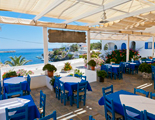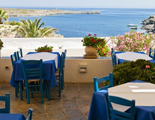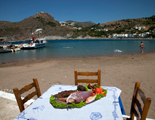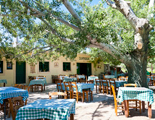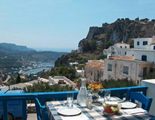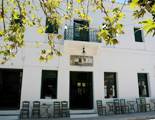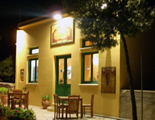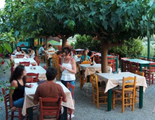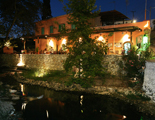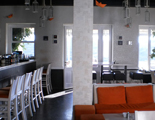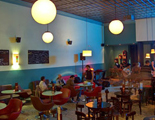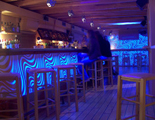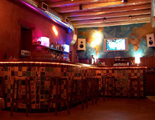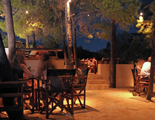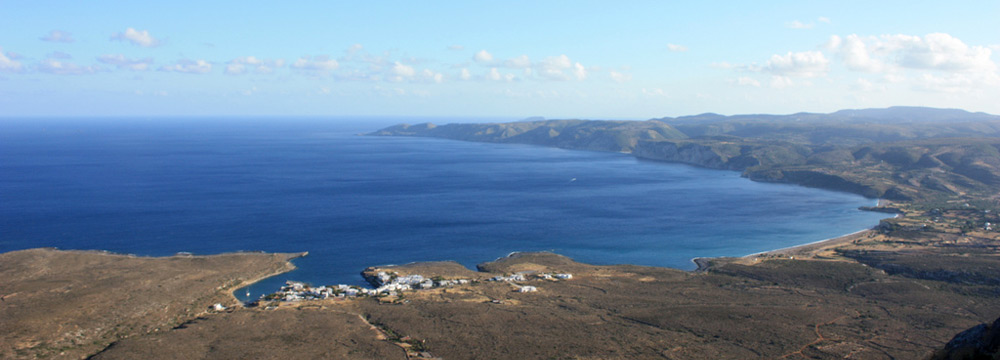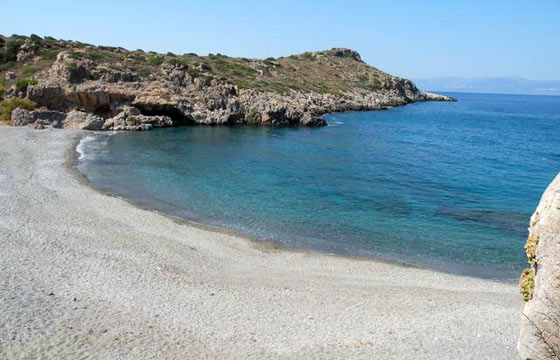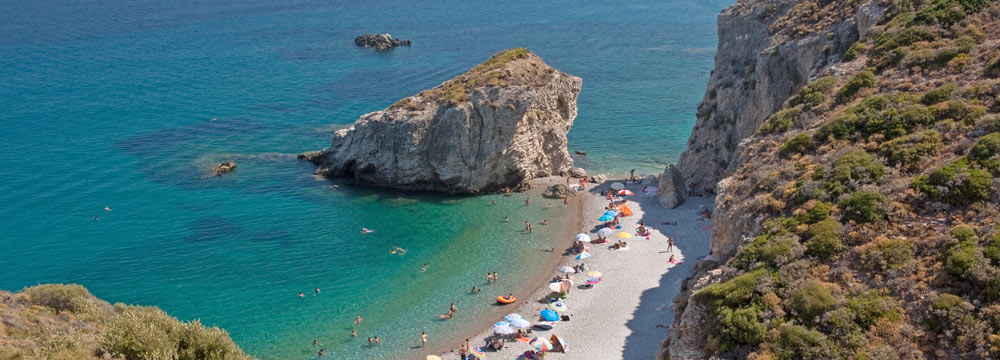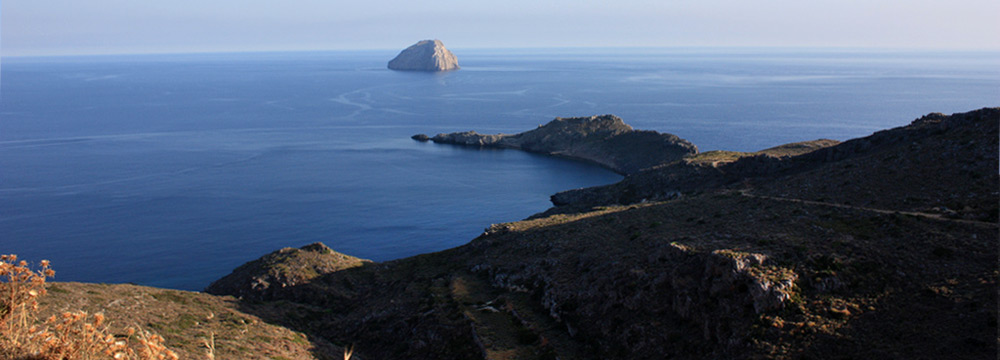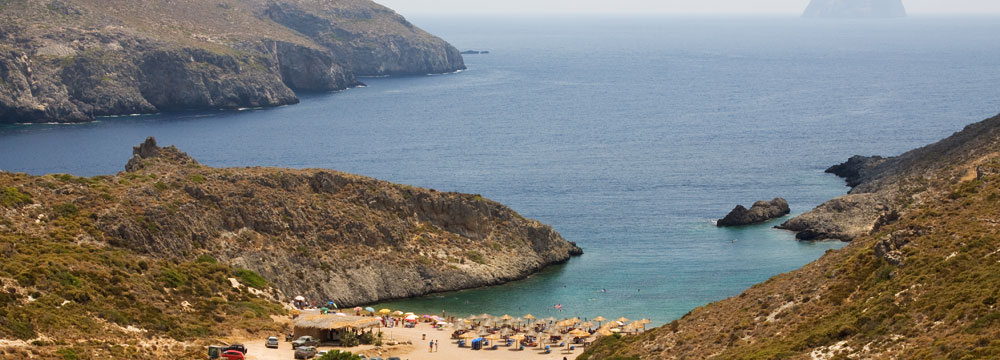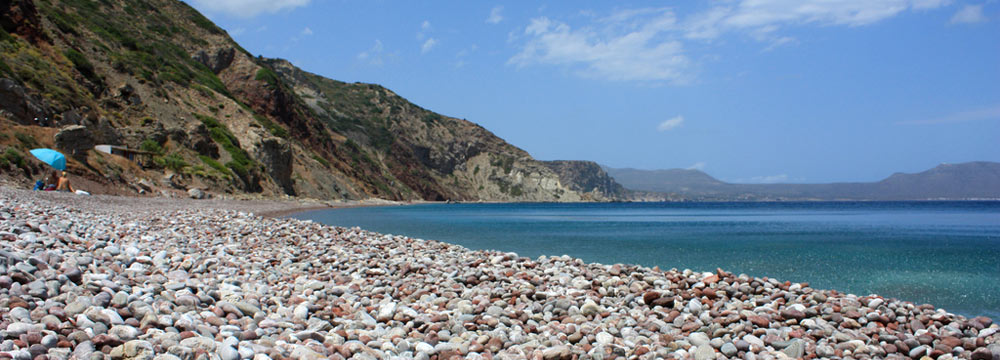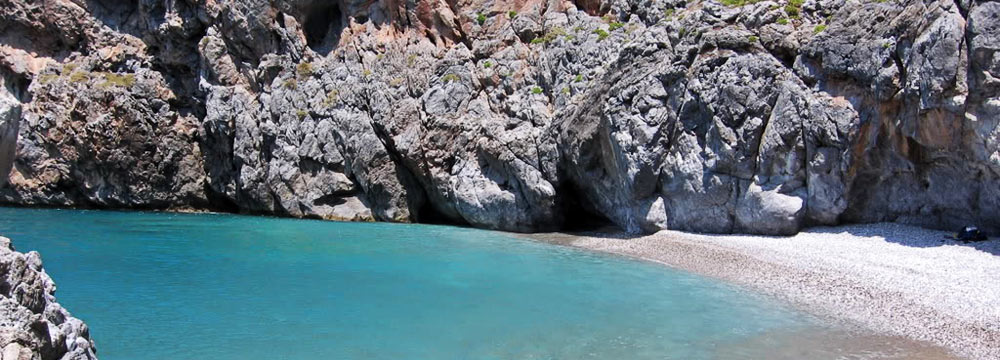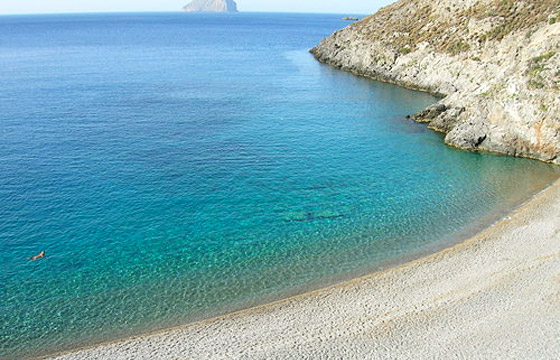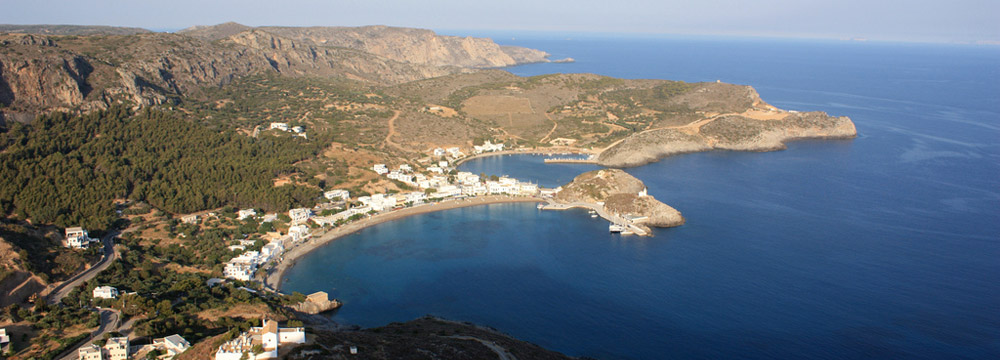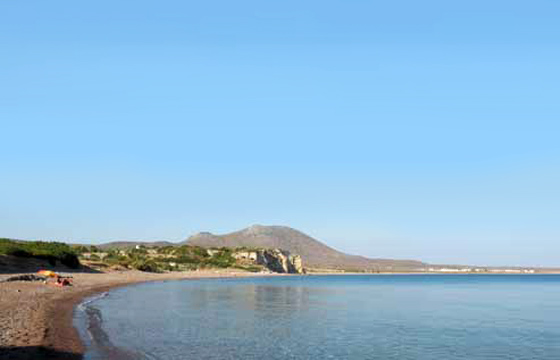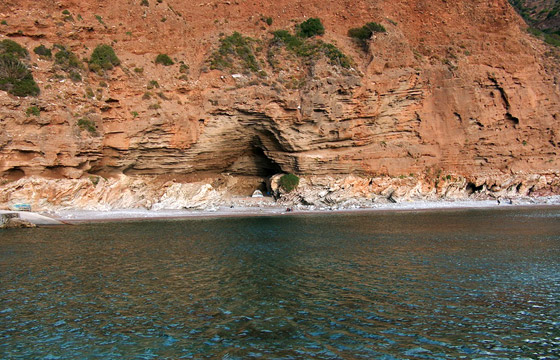 Kythira Travel Guide
Kythira Travel Guide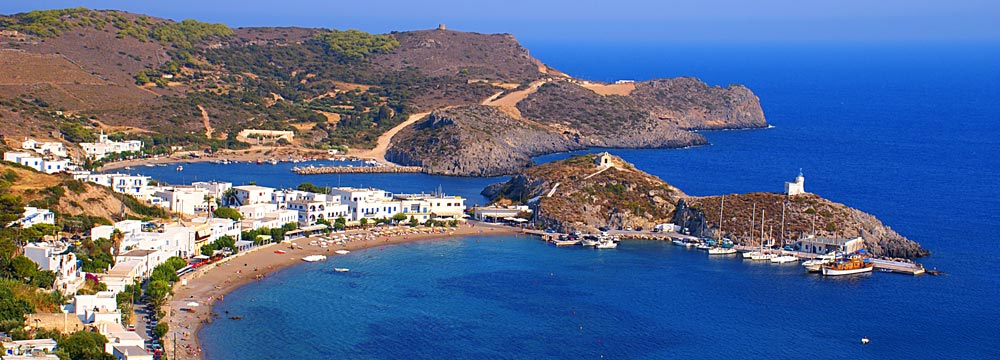
Kythira has had its name since antiquity. It is also called Tsirigo as the official name Kythira can be spelled out also as Cythera, which can be simplified and be pronounced as Tsithera. The everyday use of this name has formed it to eventually be “Tsirigo”.
The name Kythira, though, derives from the Greek word “Akyhteros”, which means the person who does not have any charms. Since Kythirawas highly connected to Goddess Aphrodite, was the Goddess of love and beauty was called Kythiria, it finally took its name from her.
In various periods in history the island was also called “Porfirousa”, as the sea algae “Porfira” used to be collected here, and “Foinikounta”, as it used to be a colony of the Phoenicians (Foinikes in Greek).
Kythira had been inhabited since the Neolithic and Proto-Hellenistic Period (end of 6.000 B.C.) as findings on various spots of the island prove. At the end of the 3rd millennium B.C. the Minoan authority expands from Crete to Kythira too and the Minoans create a commercial naval station in Palaiopoli along with various more control centres.
The island, though, after the decline of the Minoan Empire, comes against its own decline too at about the 15th century B.C., when the Mycenaeans become the new colonizers of the island. The Dorians and then the Phoenicians take control of Kythira, when, as described by Herodotus, they built the temple to Goddess Aphrodite.
In mid 6th century B.C. Kythira become a part of Peloponnese with its authority centre in Sparta and, after short rule by the Athenians after the Peloponnesian War, stay as such till the 2nd century B.C. when it finally has its proper currency, and so it is deduced that it remained autonomous and was not affected from the expansion of the Roman Empire to the east.
Kythira eventually became a part of the Eastern Roman Empire at the end of the 4th century A.D. and remained like this till the invasions of the Arab and Saracen pirates in the Mediterranean Sea in mid 6th century. Crete was devastated at that period and the consequences and raids highly affected Kythira too, whose coasts cannot be inhabited and, thereafter, trading and marine activities cannot be developed.
With the dawn of the Byzantine Empire Kythira welcomes a Byzantine family from Peloponnese (about 10th - 12th century A.D.) and Christian churches started appearing on the island. On the 13th century the Venetians append Kythira together with other islands of Greece in their sovereignty. After various conflicts and disagreements between the Venetians and the Byzantium the Ottoman admiral Barbarossa gets to the island, in 1537 A.D. and ravages and burns down Palaiohora, the principal centre of the island, enslaving and killing a great proportion of its population.
During 1797 the Venetians succumb to Napoleon and the French take the authority of all Ionian Island and Kythira too with the Campo – Formio Treaty.
At the end of the 18th century the French are the rulers of Kythira and with a symbolic plantation of the Freedom Tree in the square of Eleftherias in Estavromenos village they want to transfer the air and the ideals of the French Revolution.
The ally of Turks and Russians between 1798 and 1799 brings about destructions and the conquest of the island from Russians against the French and the discrimination of the privileges between the aristocrats and the villagers causes revolutions and murdering of “nobles” on the island.
The Treaty of Tilsit in 1807 brings the French again on the island till 1809 when the British take control. They begin constructions by suppressing the Kytherians and even after the Ionian prefecture obtains its own constitution in 1817 they continue to be the island’s rulers.
During the Greek Revolution in 1821 many immigrants from Peloponnese pass to Kythira while many Kytherians go to Peloponnese to help in the resistance and others migrate to Crete, Izmir or other areas of the liberated till then Greek state to find work.
In 1864 the Ionian Islands are integrated with Greece. In 1903 massive earthquakes devastate the island and some settlements, mainly Mitata, are completely destroyed.
At the dawn of the 20th century great waves of immigration to Australia and USA began. Also, in 1916 a company of the Cretans’ Regiment comes to Kythira to integrate the island in the “National Defense Government” by Eleftherios Venizelos and, as such, the island takes part in the 1st World War in the side of the allies (England, France and Russia) against the Germans. In the 2nd World War the Kytherians are an active power against the Germans once more.
Kythira’s immigration starts to increase again as the devastated land cannot offer work and the means to survive to the young populations, who seek their future in Athens and the main cities of Greece and they even leave the country for Australia and USA.
According to Hesiod, the ancient Greek poet, in its masterpiece “Theogony”, Kronos cut off his father’s, Uranus, urged by his thirst for power and his desire to assist his mother Gaia, who was abused by her husband, and threw them in the Sea of Kythira. From the foam they created Aphrodite was born. Aphrodite travelled to Cyprus, where she was also worshipped, but Kythirais the landmark of her birth and existence.
According to paleontologists, this myth symbolizes the emergence of the island, just like Aphrodite’s emergence from the sea foam, as the ancients believe. This is also one valid theory as there are plenty of paleontological sea findings on the island (Mitata and Variadika areas mainly).
The castle of Hora is important because of its strategic location observing the Ionian, the Aegean and the Cretan Sea at the same time. It was constructed on the 13th century A.D. during the Venetian Domination but its main part was finished in 1503 A.D.
Right in the front of the Church of Pantokratoras the headquarters of the castle is found which nowadays hosts the Historical Record of Kythira. On the headquarters’ square the former Catholic Church “Panagia of the Latinos” which was changed in 1806 A.D. to an Orthodox church under the name “Myrtidiotissa”.
You could definitely visit the castle which also provides a wonderful view from the top and combine it with a walk around Hora in the evening.
The biggest lighthouse that was ever built by the English on Greek grounds is encountered on the northern spot of the island, cape “Spathi”. It was built in 1857 and is 25 metres high. The visitor is provided with a panoramic view of the surrounding place.
To get there you must first reach the village of Mylopotamos and take it from there on foot. There is a sign that leads you to this overgrown and wonderful place with paths, brooks and large plane trees.
The waterfall of “Neraida” or “Fonissa” is 20 metres high and forms a small lake underneath it. The place is surrounded by abandoned watermills that used to work by the force of the river water for the grinding of the grains.
Finish this amazing tour into this unspoiled and blessed place with reaching the wonderful Kalami beach.
At the south east of Kythira island, right opposite the port of Kapsali, Hytra islet is found or else referred to as Avgo (meaning “Egg”). On its north part there is a water cave that is a refuge for seals. The islet is also a place where a special and protected kind of falcon called Mavropetritis (Falco eleonorae) has built its nest.
On its steep and rough ground grows the plant called Sempreviva (helichrysum orientale) which is collected every summer by the locals and is used for handicrafts.
There is a boat to take you there from the port of Kapsali.
CLIMATE
Kythira Island is located south from the Peloponnese but officially belongs to the Ionian Islands complex while administratively it is under the authority of Piraeus prefecture. Its location is of great importance as it is between Crete and the Greek mainland and it is also within the passage from the Aegean to the Ionian Sea.
The surface of the island is about 280 km2 and the total length of its coast 52 km.
The island’s climate is the typical Mediterranean with the light winters and the hot summers but, just like most Greek islands, even during the hot summer the nights are a little chilled and humid.
TELEPHONE
The national prefix for Greece is +30 if you are calling from abroad. All numbers in the capital Athens start with the prefix 210 and are followed by 7 digits (e.g. 210-3227400).
The Area Code for Kythira is: +30 27360.
If you wish to call abroad, you have to start by dialing the other country’s national prefix (i.e. 0049 for Germany, 0044 for England etc.) and continue with the area code and the number where you wish to call.
CURRENCY
Euro €
Euro Coins: 1 and 2 euro coins (gold and silver color), 10, 20 and 50 cents (gold color) 1, 2 and 5 cents (copper color)
1 euro = 100 cents / centimes.
Euro Bank Notes: Are available in 5, 10, 20, 50, 100, 200 and 500. It is not always easy to receive change for 200 and 500 Euro Notes.
BY AIR
The fastest way to reach Kythira is by air from Greece’s national airport, Eleftherios Venizelos and Olympic Air. The flight lasts about 30’ and Kythira airport is located at Simpetra, at 20km distance for Kythira Hora.
You can also travel to Kythira from Crete or catch a flight for some of the Ionian Islands, like Zante, Kefalonia and Corfu and the mainland Aktion, western Greece with Sky Express.
For more information on flights, please visit:
Athens International Airport Eleftherios Venizelos: www.aia.gr
Kythira National Airport: Tel: +30 2736033297, Email: [email protected]
Olympic Airways: For accurate timetables and ticket costs visit Olympic Air website www.olympicair.com
Athens Office: +30 210 355 0500, 8018010101
Sky Express: For accurate timetables and ticket costs visit Sky Express website www.skyexpress.gr
Athens Office: +30 2810223800, 80111282888
BY BOAT
Kythira is connected with the port of Piraeus, the port of Neapoli and Githeio, both at south Peloponnese. It is also connected with Crete but the journey is pretty long and can be rough due to the strong sea currents and winds that are pretty usual in the area and, so it is not suggested if you want to have a relaxed and pleasant journey.
From Piraeus the journey lasts about 7-8 hrs and it is usually served once a week. The trip from Neapoli is about 1 hr and 15’ and from Githeio 2,5 hrs. The trip from Kissamos, western Crete last about 4,5 hrs.
We suggest that you either take the boat from Neapoli or Githeio in order to save time and have the chance to see the beautiful south coasts of Peloponnese too.
Kythira’s main port is Diakofti, a wind protected and contemporary port, while for yachts and sailings boats there is also Agia Pelagia and Kapsali.
You can also visit Antikythira, the small island near Kythira, untouched by the human hand.
Lane Sea Lines (Kythira Office)
From Crete, Githeio and Piraeus
For accurate timetables and ticket costs visit: www.lane-kithira.com
Tel.: +30 27360 37055
Mob: +30 6933087777
Email: [email protected]
F/B Porfyrousa
From Neapoli
For accurate timetables please call:
Tel: +30 27340 24004 / 29004 (bookings from Neapoli)
Tel: +30 27360 31390 (bookings from Kythira)
Diakofti Port Authority: +30 27360 34222
Agia Pelagia Marina Authority: +30 27360 33280
Kapsali Marina Authority: +30 27360 31222
Piraeus Port Authority Tel.: +30 210 4226000, 210 4114005
Antikythira Information
Community of Antikythira: +30 27360 31930 / email: [email protected]
For accurate timetables and ticket costs you can communicate with Agia Pelagia Marina Authority and the Marina Authority of Diakofti.
LOCAL BUSES
In Kythira there are no regular bus routes throughout the year but during the touristic season the municipality operates frequent routes with buses that run from the airport and port to the island’s main villages and Hora. The buses also connect the villages between them.
The routes are announced in various travel agencies on the island and you can also find timetables and further information in various local authorities.
For more information on timetables and routes, please call the municipality of Kythira: +30 27360 31213
TAXI SERVICE
There are a few taxis that you will find useful for your transportation on the island of Kythira.
Find below some telephones of local taxi drivers:+30 6945 227480, +30 6944 314125, +30 6944 746246, +30 6977 865162, +30 6944 931354
RENT A CAR/MOTORBIKE
It is advisable to have your own vehicle in order to discover all the hidden gems of Kythira at your own time.
You will find quite a few car / moto rental agencies on the island of Kythira, and mostly in Hora and the larger villages (Agia Pelagia, Kapsali).
BANKS & ATMS
On the island there are not many branches of Greek banks. You will find though two branches of the National Bank of Greece (Hora and Potamos village) and one branch of the Agricultural Bank of Greece (Hora).
MONEY EXCHANGE
Banks exchange all major currencies, traveler’s cheques or Eurocheques. Post offices exchange cash, but not traveler’s cheques, and usually charge lower commissions than banks. Travel agencies and larger hotels exchange cash and traveler’s cheques but usually charge a higher commission. Credit cards are accepted in shops and restaurants, however, in local cafes, especially in villages you will probably have to pay in cash.
POST OFFICE
The Greek post office is called ELTA. Post Boxes in Greece are YELLOW for normal post, usually with 2 slots for INTERNAL POST (meaning inside Greece) and post for ABROAD. RED Post Boxes are rarer and they are used for URGENT mail. REGISTERED mail is always handled and given a receipt for at the POST OFFICE.
Kythira (Hora) Post Office Tel.: +30 27360 31274
POLICE STATION
Kythira (Hora) Police Station Tel.: +30 27360 31206
Potamos Police Station Tel.: +30 27360 33222
MUNICIPALITY OF KYTHIRA
Hora, Tel.: +30 27360 31213
- Tourist Police: 171
- Hellenic National Meteorological service: +30 210 9699101-3
- Elpa (Car breakdown tourist information service): 174
It is not certain that you will find international press on Kythira so be prepared and take it with you from Piraeus, Athens or Peloponnese.
EMERGENCY NUMBERS
- Police: 100
- Fire Department: 199
- Ambulance: 166
Potamos Hospital/Health Centre Tel.: +30 27360 33222
Potamos Rural Health Centre Tel.: +30 27360 33213
Hora Rural Health Centre Tel.: +30 27360 31243
Kato Livadi Rural Health Centre Tel.: +30 27360 31536
Karvounades Rural Health Centre Tel.: +30 27360 38015
PHARMACY
On Kythira there are two private pharmacies, at Potamos and Karvounades, and one within the hospital, at Potamos.
Potamos Pharmacy Tel.: +30 27360 34220
Karvounades Pharmacy Tel.: +30 27360 38055
This is a small creek that looks more like a natural carved swimming pool. The waters are crystal clear and the swimmers can lie over its small flat rocky surface. The surrounding village of Avlemonas is a picturesque fishing settlement with plenty of rooms to let, restaurants and cafes to choose from.
Found on the north eastern part of Kythira, Fourni is an organized pebbled beach with clear emerald waters. The access is through a dust road from the central road leading to Platia Ammos to the east. The beach is ideal for naturists and privacy seekers and its untouched landscape will surely steal your heart.
Kaladi beach is commonly accepted as one of the most popular and beautiful beaches on the island. It is located on its eastern side right next to Paleopolis beach. A pebbly beach with clear waters divided into three parts. A big rock is the main characteristic of it. After driving a few metres on a dust road you must park and descend the stone stairs to reach it. It is not organized so you must be prepared and equipped with water supplies, snacks and clothing or umbrella for the sun.
Melidoni is located on the northwestern part of the island and is definitely one of the best beaches on Kythira. It is a small bay with thin sand and a beautiful view to Hytra islet. It is organized with a canteen, umbrellas and sunbeds. The road leading there is narrow and winding, so attention is required. There is also the alternative way of approaching the beach by boat from Kapsali port.
Chalkos is one of the most popular and crowded beaches on the island. Its crystal clear blue waters and the pebbly coast are really something while it is organized too with sunbeds and umbrellas which will definitely come in handy as there is no particularly much of natural shade. Chalkos is located only a few kilometers away from Kalamos village on the south part of the island and provides for a parking lot too. The emerald waters and the picturesque cove shaped by the surrounding cliffs create a charming ambience for great summer days!
This is a large beach located on the south east part of Kythira, quite close to Kalamos village. Although it is one of the most popular beaches it is not crowded due to its size, as it is pretty long while narrow at the same time. It is a pebbled beach with clear waters and is also organized with a canteen, umbrellas and sunbeds. The parking is a little tricky because the only space available is the narrow descending road leading to it.
Kalami is an isolated, small beach close to Mylopotamos village on the western part of the island. Ideal for those who enjoy relaxation away from crowded spots. The access is difficult because one must walk a dust trail for about 15 minutes and then climb down some steep rocks to get there. The waters are deep and at the bottom you can observe some sunken canons. The serenity and wild beauty of this place, though, is definitely worth the trouble!
Sparagario is a small beach located next to Kapsali beach to the west formed to the end of a ravine descending from Hora to the sea. It is isolated and thus perfect for those who seek tranquility and relaxation. You can reach it by the sea from Kapsali beach or walk through the path that climbs the rocks that surround it. Either way, you should definitely visit this secluded heaven!
Kapsali beach is a large sandy and pebbled beach located on the south part of the island, at about 2km distance from Hora. It is organized with all the basic amenities such as umbrellas, sunbeds and also water bicycles are provided. The beach has a wonderful view to Hytra islet and to the castle of Hora that stands above it. The access is easy and there are plenty of bars, cafes, restaurants to choose from. Next to this beach another rocky bay exists for the more daring ones. Both beaches can be pretty crowded during summer.
This one is the largest beach on the island and is located to the east before arriving to Avlemonas village. Access to the beach is really easy and its coast is partially sandy and pebbled. Paleopolis is not organized and there is no natural shade, so visitors should be prepared with umbrellas. The waters here are clean and deep while the place is also preferred by nudists since it is a rather secluded beach, although pretty large and picturesque.
Signs lead you from Logothetianika village to Lykodimou beach through a winding road offering a very nice scenery. This one is a large beach, sandy and pebbled at parts and a cave is naturally formed at the fond, which provides natural shade. It is organized with umbrellas and sunbeds and a canteen as well. Although the beach is organized and really beautiful it is rarely crowded.
This is a variation of the traditional Greek dish “pastitsio” made with pasta, minced meat in red sauce and a kind of béchamel, all of them in layers and baked in the oven. The Venetian Pastitsio is pretty different than the traditional, popular delicacy as it also contains pasta but the red meat sauce on the upper layer consists of minced meat and small pieces of beef liver. Its main difference though is in the dough; at the bottom of the baking pan a thin layer of dough is added, on top of it the pasta with the grated cheese and then another layer of dough on top takes the place of the béchamel. A quite interesting taste, a dish really worth trying!
The prickly cactus is a type of cactus, pretty popular in Greece, producing a kind of figs that have are completely in sight and in taste than normal figs, called prickly pears. This dish is made of a steak that is cut in the middle creating some kind of an envelope. In there the stuffing is added that composes of apple, raisins, celery, trimmed toast bread, parsley, onions, sage, some boiled chicken juice, milk and one egg. The stuffing is mashed altogether and added in the “enveloped” steak. The steak is baked or roasted and is accompanied by a sauce made with butter, flour, wine, rosemary and some boiled beef juice, all boiled together until the mixture becomes curdy. But the highlight of the dish is the fried prickly cactus leaves from which they rub off the tiny spines and they are added in a frying pan with onion, parsley, garlic and some lemon. This is what we call creative cuisine!
A delicacy well known in various places of Greece made with homemade dough, here also including some sweet “ouzo” (a popular alcoholic drink in Greece) which is shaped and fried. When the Xerotigana are ready, they top them with honey, sesame and some cinnamon.
A special dish made with “tsipouro”, a typical Greek alcoholic drink, which is closed in a jar with the skin of 8 tangerines. The mixture stays there closed up for about one week, stirred at times. A syrup with sugar and water is then prepared and added in the jar with some cinnamon and cloves. Definitely worth trying!
The octopus is cut into small pieces and poured over with some wine. After some time, in a foil some olive oil, garlic, laurel leaves and pepper arte added together with the octopus. The mixture is baked in the oven, closed up in the foil and is served with lettuce leaves and oregano. A great “meze” for some tsipouro or wine!
The aubergines are cut into small pieces and sautéed in a frying pan with onion and fresh tomato sauce. The frumenty, which has already been soaked up in water in order to soften and “inflate” is added in the aubergines and the sauce with some parsley and spearmint. The mixture is baked altogether for about 30’ until it thickens. A light and delicious dish with typical Greek products.
This is a very distinctive dish made with sea urchins that are stuffed with rice, tomato, onion, herbs and some hard, salty Greek cheese “Kefalotiri”. The sea urchins are emptied by their juices but their eggs remain in them and their spines are removed. The stuffing is prepared separately in a frying pan and then each urchin is stuffed with the sauce made with onions and tomatoes. After they are stuffed, they are put into a casserole with the rice, more tomato and onion and a part of their juices. It is boiled till the rice is ready. The eggs of the sea urchin and its juices give a unique flavor to this, otherwise, simple risotto dish.
The mill pastry has taken its name from the almonds that our ground in the mill. It is a very old, traditional recipe of Kythira that results in a tasty cake of almonds with a vanilla topping.
Another typical Kythirian product that is made with ground almonds, sugar, honey, cinnamon, some water and semolina. All ingredients are blended in a bowl and then the almond “dough” is shaped in thick sticks shapes. They are baked in the oven and they are a perfect, nutritious snack to accompany your coffee or tea.
Mpizedes is anther simple yet favorite local sweet made with the egg white, sugar, lemon juice, almonds cut in thick pieces and flakes of the lemon’s skin. The eggs’ whites are boiled in a casserole while being whipped with sugar. When the mixture gets thicker, the lemon juice and the flakes of its skin are added. Then small cones are shaped with the mixture and are baked in the oven. Sweet and sour and, of course, delicious!
A variation of the popular pumpkin pie made with sweet pumpkin, currants, nuts, cones, rusks, cloves and cinnamon. After the pie is ready and baked in the oven it is poured with honey syrup and sesame.
This is a variation of the typical Greek bread that also contains cinnamon, sugar, cloves and honey. The production of this bread requires a little more attention when kneaded and baked due to all the extra ingredients. The result, though, is more that rewarding!
Melohontros is composed by the Greek words “meli”, meaning “honey”, and “xontros”, meaning “thick”. This is a sweet dessert made with honey and semolina, which, in older times, was prepared with ground wheat instead of semolina and honey from honeycombs.
The most popular and delicious product of Kythira is the oil rusks which are just like common rusks only they contain a great amount of olive oil. They can be found all over the island as it is something like its mascot!
Try them with tomato and feta or graviera cheese…just unique!
Kythira thyme honey is among the most quality honeys in the world. The island occupies a lot with honey production and the Apicultural Cooperation of Kythira is a great initiative and high esteemed on the island.
Honey can be bought from the Cooperation or the producers directly, though at a little higher price as the production is pretty limited.
Kythira is a very fertile island when it comes to olive oil production. Many inhabitants occupy themselves with the olive oil production and the produced oil is of great quality and always a basis for local dishes and products, like the Kytherian olive rusks.
Besides, Kythira lies at the foot of the Peloponnese and its olive tree variety “koroneiki”, one of the best olive varieties, bursts on the island too.
Deriving from the Latin words “semper” and “vivere” meaning “lives forever”, sempreviva is the island’s landmark. A small yellow flower, looking as dried, is the unique, distinctive product of Kythira. It was named like this from the Venetian conquerors of the island who noticed that when they cut it, it remained unaltered as the time passed by.
Sempreviva (helichrysum orientale) has small leaves have a characteristic straw texture feeling, tiny yellow blossoms and it grows at steep spots on the northwest part of the island and on Hytra islet. The blossom of sempreviva is used for handicrafts and decoration ornaments.
The sausages from Kythira are pretty famous and a great “meze” to accompany some of the local, delightful wine. You can find them in almost any butchery on the island.
The local cheese, herbs, sweets, almonds and fruits are also a great choice when it comes to shopping traditional products while vacationing on the island.
A Bio Cooperation also operates on the island supplying the island’s shops, taverns and, of course, visitors with high quality, chemical-free nutrition products.
A festival, resembling a gastronomy and cooking seminar, takes place on Kythira during July when traditional recipes are cooked in front of the visitors, who then can taste some of the produced dishes. A fair that exhibits the local products from producers of the island is also available during the festival. The living traditional of the island!
The annual Wine festival takes place each year in Mitata village, during the first weekend of August, in honor of the wine, the wine production and its great part in the local economy and traditional. As any typical festival in Greek islands and areas, this one too includes a lot of local delicacies, local wine and folk music and dances. Should not miss that!
Each year, especially during the summer season, the municipality of Kythira organizes various cultural, artistic and fair events including art exhibitions, concerts, theatrical plays starring Greek and foreign artists
At the end of August each year the Agricultural Festival takes place in Fratsia, one of the island’s large villages right in its centre. The festival is held in a traditional ambience where local women dressed in traditional costumes guide visitors through the island’s agricultural production and offer them a treat. The goal of this festival is to promote the local products including olive oil, honey, herbs, spoon sweets, wine, cheese, but also non-comestible products like pottery, ceramics and textiles. Visitors can try or buy any of those products. The festival, typically, ends up in an open air feast of eating, drinking and dancing.
During 2011 and 2012 Kythira in order to honor the European Day of Music has organized a festival dedicated to music and all its kinds. This festival has ended up to be a great success as most cultural associations of the island have contributed to its organization up to now while the feast lasts about 3 days at the end of June from the 20th till the 22nd (the summer solstice on the 21st June).
Drawn by the initiative of the Youth Association of Kythira “Porphyris” this festival has been taking place since 2001 hosting various artistic and photography exhibitions, concerts and parties. A must for the young people and the lovers of art and entertainment.
One of the most popular feasts of Kythira is the Myrtidiotissa Celebration, which is mostly a religious event that takes place in the end of September each year at the Monastery of Myrtidiotissa in honor of the Holy Mary.
On the 15th of August the typical Greek celebration in the honor of Holy Mary takes place at the central square of Potamos village, accompanied as usually with folk music, traditional dances, local dishes and drinks.
Another pretty important event is the celebration of the holy patron of the island, Osios Theodoros on May 12th in the same festive context as all the rest of the religious events.
The sun is very strong in summer and especially in August from 11.00 to 16.00. You should often use a high factor sun block, always wear a hat and sunglasses.
You should be very careful when you drive a car or a motorbike because the roads usually are not well maintained and they are often narrow and winding.
Although not an overcrowded destination, mind that it is important to book your return ferry ticket from Kythira to Neapolis on time since you cannot book your return tickets in advance. Besides the routes are not very frequent and there is a small possibility of not finding easily a return ticket.
Always be prepared and book your hotel room in advance so as to avoid unpleasant surprises. Especially in August, which is the high season in Greece, most destinations are full with visitors and the odds are that it will be difficult to find what you are looking for and at a good price if you have not booked it beforehand.
Antikythira (Tsirigoto or Lioi) is a small hidden gem, only two hours away from Kythira by boat. Almost 45 inhabitants live there “away from civilization”. It is a paradise for those who seek tranquility. There is no gas station, nor bakery, not even a bank and once a week supplies reach the island by boat.
The baked wild goat, thyme honey, wine and fresh fish are the unique delicacies offered there. The road network is good and the island is covered by mobile phone network services. Because of the lack of touristic infrastructure the island can only hold a relatively small number of visitors.
Every summer on the 16th and 17th of August is held the celebration of the Patron Saint, martyr Myronas with traditional Cretan live music, dance and food.
Either you are an adventurer or a more “relaxed” traveler, Kythirais one of the ideal places in Greece for endless explorations. As its scenery is untouched by tourism, you should definitely walk around its magnificent villages and explore all its hidden corners and coasts.
For the trekking and discovery lovers, the path that leads from Hora to Kapsali is a must-do. The distance is about 3km but the views, especially when you ascend the slope, at the area of Hora’s Castle, are just unique!
In case you find a caique that offers a boat trip to Hytra Islet, just not let this opportunity pass by usually there are organized trips with a guide so mind to take the afternoon ride and live the experience of exploring a wild paradise.
Hytra does not have beaches or any kind of infrastructure but the seaside cave is definitely something you should visit with your mask.
In case you wish to take a “piece” of Kythira back with you, then stroll around the streets of Hora, Kapsali, Mitata, Avlemonas and you will discover various small shops selling traditional products from olive oil, honey and homemade sweets to pottery, semprevivas and art objects.

 Print this page
Print this page